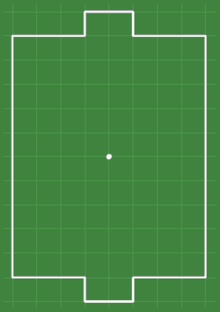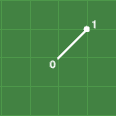Paper Soccer
Paper Soccer (or P&P Soccer or Paper Hockey, or Paper Football or Logic Football[1][2]) is a pencil and paper game for two players. In Poland, Russia, Slovakia, Romania, Germany and other countries the game is popular among school children and students. There are several variations of this game. Here the two most distinct versions are described:
Version 1
On a square lined sheet of exercise book the players draw rectangular field with even number of squares along each side. Exact size of the field doesn't matter (as a rule it ranges from a half of the sheet to a whole sheet). At centers of the field's shorter sides gates boundaries are marked with two dots on each side so that the length of each gate is also even number of squares and is about a quarter of the field's side length (in some game variations the gate size should be exactly 6 squares). Center of the field itself (centre spot) is also marked with a dot - this is initial position of the "ball". From here the game begins.
Aim of the game is to move the "ball" into the opponent's gate.
- Players make their moves one after another. Who makes the first move is decided by toss.
- "Making a move" means to draw (generally) a jogged line ("ball" trace) through empty dots at line crossings of our square lined sheet. In one game variation the line consists of 4 spans connecting the nearest dots along square's sides, in another - it consists of 3 spans but they can pass also along square's diagonals.
- The line should not intersect itself, previously drawn lines or the field boundary except of the gates. There is one exception here - penalty kick (see below).
- Beginning of one line should start at the end of previously drawn line. First line starts at the centre spot.
- If the player is unable to draw the line (without crossing another lines or the field boundary) then his opponent should make the penalty kick: from the end of the previous move he draws a line 6 (13 in some game variations) spans of length in any of the eight directions. This penalty line can cross another lines except of the field boundary. If the penalty line stops on already occupied dot or the player again is unable to make his move from this point, his opponent makes the penalty kick again.
- If the penalty line touches the gate boundary dot (the goalpost) the line should bounce (like a beam of light bounces from a mirror) but the whole penalty line length should be still exactly 6 (or 13) spans. In some game variations the penalty line cannot bounce.
- If the line (during regular move or penalty kick) crosses the gate - the player scores a goal and the game starts again at the centre spot of the same field or on an empty field. Loser makes the first move here. In another variation the game stops after the first goal.
Version 2

The game starts on an empty field of (usually) 8×10 boxes, with goals of two boxes wide marked in the centers of the two shorter sides. In the beginning, a ball is drawn in the center of the field, on the crossing of the paper lines.
Players take turns to "move" the ball into one of the eight paper line crossings around it (horizontally, vertically, or diagonally) and a segment from the original position to the new one is drawn to mark the move. The ball may move neither on the game field border nor on the segments marking the previous moves - instead, it "bounces" from them: a player who moves the ball into a position where there is already an end of a segment or a game field border gets another turn.
The first player to place the ball in the opponent's goal wins the game. The game may also end when a player does not have a valid move, in which case that player loses.
Example moves
|
References
| Wikimedia Commons has media related to Paper soccer. |

